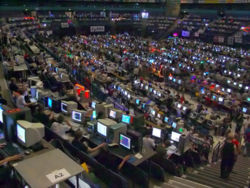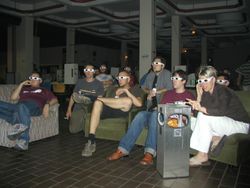- Demoparty
-
DemosceneConcepts Demo - Intro - Demoparty - Effects - Demogroup - Compo - Music disk - Diskmag - Module file - Tracker Alternative demo platforms Amiga - Apple IIGS - Atari ST - Commodore 64 - Vic-20 - Text mode - ZX Spectrum Parties Current: Alternative Party - Assembly - Buenzli - Evoke - The Gathering - Sundown - X Past: Breakpoint - Mekka & Symposium - The Party Websites Hornet Archive - Scene.org - Mod Archive - Trax in Space Software ProTracker - Scream Tracker - Fast Tracker - Impulse Tracker - ModPlug - Renoise Tracker musicians Demosceners A demoparty is an event that gathers demosceners [1] and other computer enthusiasts to compete in competitions.[2] A typical demoparty is a non-stop event lasting over a weekend, providing the visitors a lot of time to socialize. The competing works, at least those in the most important competitions, are usually shown at night, using a video projector and big loudspeakers. The most important competition is usually the demo compo.[3]
Contents
Concept
The visitors of a demoparty often bring their own computers to compete and show off their works. To this end, most parties provide a large hall with tables, electricity and usually a local area network connected to the Internet. In this respect, many demo parties resemble LAN parties and many of the largest events also gather gamers and other computer enthusiasts in addition to demosceners. A major difference between a real demoparty and a LAN party is that demosceners typically spend more time socializing (often outside the actual party hall) than in front of their computers.[4]
Large parties have often tried to come up with alternative terms to describe the concept to the general public. While the events have always been known as "demoparties", "copyparties" or just "parties" by the subculture itself, they are often referred to as "computer conferences", "computer fairs", "computer festivals", "computer art festivals", "youngsters' computer events" or even "geek gatherings" or "nerd festivals" by the mass media and the general public.
Demoscene events are most frequent in continental Europe, with around fifty parties every year. In comparison, there has only been a dozen or so demoparties in the United States in total. Most events are local, gathering demomakers mostly from a single country, while the largest international parties (such as Breakpoint and Assembly) attract visitors from all over the globe.[5]
Most demoparties are relatively small in size, with the number of visitors varying from dozens to a few hundred. The largest events typically gather thousands of visitors however, although most of them have little or no connection to the demoscene. In that aspect, the scene separates "pure" parties (which abandons non-scene related activities and promotion) from "crossover" parties.
History
Demoparties started to appear in the 1980s in the form of copyparties where software pirates and demomakers gathered to meet each other and share their software. Competitions did not become a major aspect of the events until the early 1990s.
Copyparties mainly pertained to the Amiga and C64 scene. As the PC compatibles started to take over the market, the difficulties in easily making nice demos and intros increased. Along with increased police crackdowns on copying of pirated software, the "underground" copyparties were gradually replaced by slightly higher-profile events which came to be known as demoparties. However, some of the "old school" demosceners still prefer to use the word "copyparty" even for today's demoparties.
During the 1990s, the focus of the events shifted away from illegal activities into demomaking and competitions. The copying of copyrighted material was often explicitly prohibited by the organizers, and many events also forbade the consumption of alcohol. However, illegal copying and "boozing" still continued to take place, although in a less public form.
Three well-known and appreciated large-scale demoparties were established in the early 1990s: The Party in Denmark, Assembly in Finland and The Gathering in Norway. Taking place every year and gathering thousands of visitors, these parties used to be the leading demoscene events in this period. Assembly still retains this status today. The Gathering continues to be organized yearly as a generic "computer party", but most of the demosceners now prefer Breakpoint in Germany which takes place at the same time.
The emergence of high-profile demoparties gave rise to phenomena which were not always well welcomed by the scene. The events started to attract unaffiliated computer enthusiasts who were often generally referred to as "lamers" by the original attendants. A particularly visible group in the large gatherings since the mid-1990s have been the LAN gamers, who often have very little interest in the demoscene and mainly use the party facilities for playing multi-player computer games. However, many of today's demosceners received their first interest for demos and demomaking from a visit to a large demoparty.
Common properties
Parties usually last from 2 to 4 days in length, most often Friday to Sunday to ensure that sceners who work or study are also able to attend. Small parties (under 100 attendants) usually take place in cultural centres or schools, whereas larger parties (over 400-500 people) typically take place in sports halls.
Entrance fees are usually between €10 and €40 given the size and location of the party. It is still a common practice in many countries to allow females to enter the party for free (mostly due to the low concentration of female attendees, which is usually under 20%), albeit most parties enforce an "only vote with ticket" rule, which means that an attendee who got in free can only vote with a paid ticket.
Attendees are allowed to bring their desktop computer along, but this is by no means a necessity, and is usually omitted by most sceners, especially who travel long distance. Those who have computer-related jobs may even regard a demoparty as a well-deserved break from sitting in front of a computer. For those who do bring a computer, it is becoming increasingly common to bring a laptop or some sort of handheld device rather than a complete desktop PC.
Partygoers often bring various senseless gadgets to parties to make their desk space look unique; this can be anything from a disco ball or a plasma lamp to a large LED display panel complete with a scrolling message about how "elite" its owner is. Many visitors also bring large loudspeakers for playing music. This kind of activity is particularly common among new partygoers, while the more experienced attendees tend to prefer a more quiet and relaxed atmosphere.
Those who need housing during the party are often offered a separate "sleeping room", usually an isolated empty room with some sort of carpet or mats, where the attendees are able to sleep, separated from the noise. Most sceners prefer bringing sleeping bags for this, as well as inflatable mattresses or polyfoam rolls. Parties who don't offer a sleeping room generally allow sceners to sleep under the tables.
Partyplaces often become decorated by visitors with flyers and banners. These all serve promotional reasons, in most cases to advertise a certain group, but sometimes to create promotion for a given demoscene product, such as a demo or a diskmag, possibly to be released later at the party.
A major portion of the events at a demoparty often take place outdoors. Demosceners usually spend considerable time outside to have a beer and talk, or engage into some sort of open-air activity such as barbecueing or sport, such as hardware throwing or soccer. It is also a common tradition to gather around a bonfire during the night, usually after the compos.
In recent years, many parties were available for spectators through the Internet: This traditional was first started by the live team of demoscene.tv, who broadcasted from the event live or created footage for a postmortem video-report. This was ostensibly replaced now by the SceneSat radio crew who provide live streaming radio shows from parties, and larger parties now offer their own dedicated streaming video solution.
See also
- Compo
- Demoscene
- List of demoparties
References
External links
- Demoparty.net - collective demoscene party database
- Slengpung - Demoscene party pictures, videos and party reports.
- Assembly07 TV report
- breakpoint05 report on German TV(English subtitle)
- faq about demoscene
- a book!
Categories:- Demoscene
- Demo parties
- 3D computer graphics
Wikimedia Foundation. 2010.




